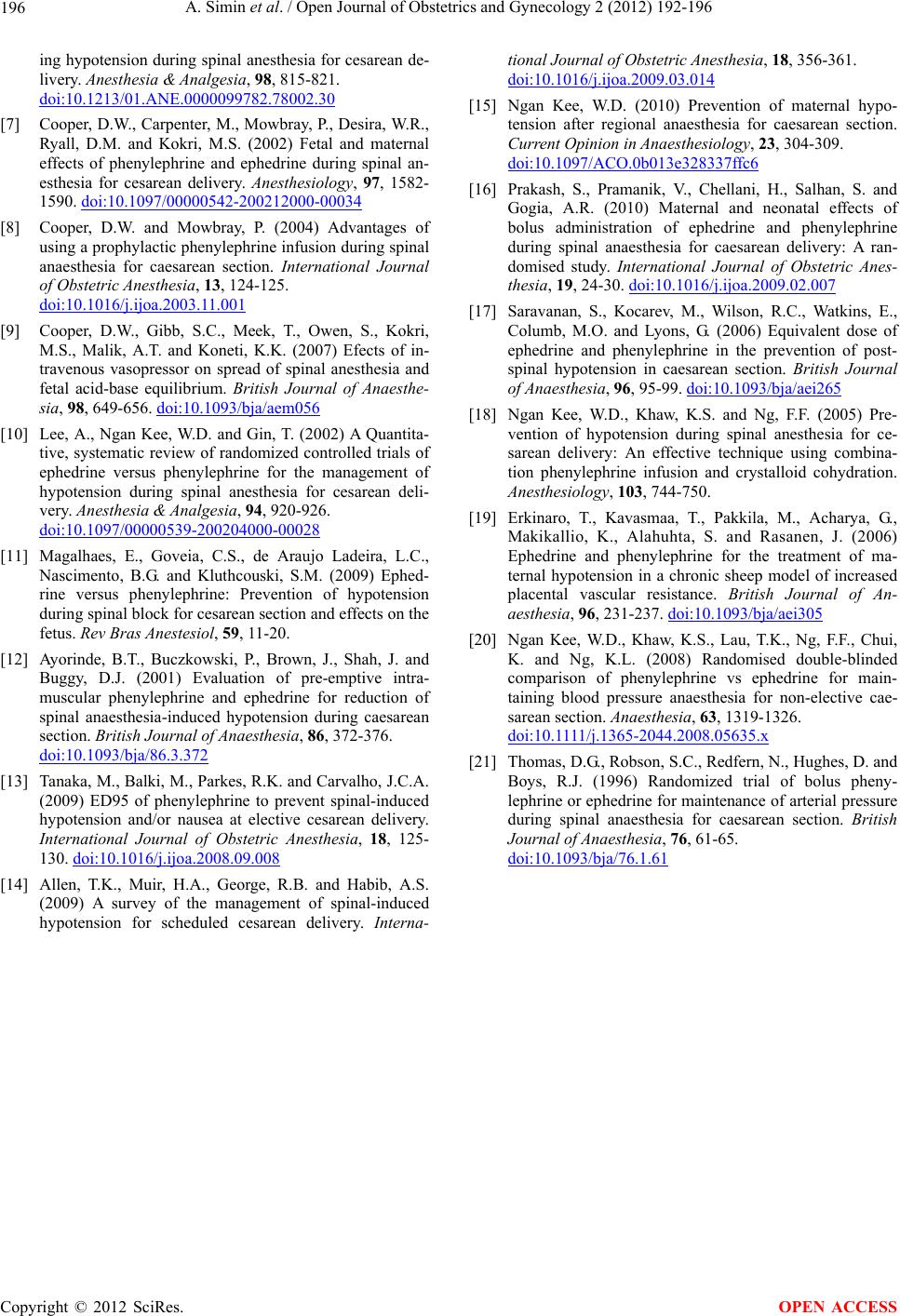
A. Simin et al. / Open Journal of Obstetrics and Gynecology 2 (2012) 192-196
196
ing hypotension during spinal anesthesia for cesarean de-
livery. Anesthesia & Analgesia, 98, 815-821.
doi:10.1213/01.ANE.0000099782.78002.30
[7] Cooper, D.W., Carpenter, M., Mowbray, P., Desira, W.R.,
Ryall, D.M. and Kokri, M.S. (2002) Fetal and maternal
effects of phenylephrine and ephedrine during spinal an-
esthesia for cesarean delivery. Anesthesiology, 97, 1582-
1590. doi:10.1097/00000542-200212000-00034
[8] Cooper, D.W. and Mowbray, P. (2004) Advantages of
using a prophylactic phenylephrine infusion during spinal
anaesthesia for caesarean section. International Journal
of Obstetric Anesthesia, 13, 124-125.
doi:10.1016/j.ijoa.2003.11.001
[9] Cooper, D.W., Gibb, S.C., Meek, T., Owen, S., Kokri,
M.S., Malik, A.T. and Koneti, K.K. (2007) Efects of in-
travenous vasopressor on spread of spinal anesthesia and
fetal acid-base equilibrium. British Journal of Anaesthe-
sia, 98, 649-656. doi:10.1093/bja/aem056
[10] Lee, A., Ngan Kee, W.D. and Gin, T. (2002) A Quantita-
tive, systematic review of randomized controlled trials of
ephedrine versus phenylephrine for the management of
hypotension during spinal anesthesia for cesarean deli-
very. Anesthesia & Analgesia, 94, 920-926.
doi:10.1097/00000539-200204000-00028
[11] Magalhaes, E., Goveia, C.S., de Araujo Ladeira, L.C.,
Nascimento, B.G. and Kluthcouski, S.M. (2009) Ephed-
rine versus phenylephrine: Prevention of hypotension
during spinal block for cesarean section and effects on the
fetus. Rev Bras Anestesiol, 59, 11-20.
[12] Ayorinde, B.T., Buczkowski, P., Brown, J., Shah, J. and
Buggy, D.J. (2001) Evaluation of pre-emptive intra-
muscular phenylephrine and ephedrine for reduction of
spinal anaesthesia-induced hypotension during caesarean
section. British Journal of Anaesthesia, 86, 372-376.
doi:10.1093/bja/86.3.372
[13] Tanaka, M., Balki, M., Parkes, R.K. and Carvalho, J.C.A.
(2009) ED95 of phenylephrine to prevent spinal-induced
hypotension and/or nausea at elective cesarean delivery.
International Journal of Obstetric Anesthesia, 18, 125-
130. doi:10.1016/j.ijoa.2008.09.008
[14] Allen, T.K., Muir, H.A., George, R.B. and Habib, A.S.
(2009) A survey of the management of spinal-induced
hypotension for scheduled cesarean delivery. Interna-
tional Journal of Obstetric Anesthesia, 18, 356-361.
doi:10.1016/j.ijoa.2009.03.014
[15] Ngan Kee, W.D. (2010) Prevention of maternal hypo-
tension after regional anaesthesia for caesarean section.
Current Opinion in Anaesthesiology, 23, 304-309.
doi:10.1097/ACO.0b013e328337ffc6
[16] Prakash, S., Pramanik, V., Chellani, H., Salhan, S. and
Gogia, A.R. (2010) Maternal and neonatal effects of
bolus administration of ephedrine and phenylephrine
during spinal anaesthesia for caesarean delivery: A ran-
domised study. International Journal of Obstetric Anes-
thesia, 19, 24-30. doi:10.1016/j.ijoa.2009.02.007
[17] Saravanan, S., Kocarev, M., Wilson, R.C., Watkins, E.,
Columb, M.O. and Lyons, G. (2006) Equivalent dose of
ephedrine and phenylephrine in the prevention of post-
spinal hypotension in caesarean section. British Journal
of Anaesthesia, 96, 95-99. doi:10.1093/bja/aei265
[18] Ngan Kee, W.D., Khaw, K.S. and Ng, F.F. (2005) Pre-
vention of hypotension during spinal anesthesia for ce-
sarean delivery: An effective technique using combina-
tion phenylephrine infusion and crystalloid cohydration.
Anesthesiology, 103, 744-750.
[19] Erkinaro, T., Kavasmaa, T., Pakkila, M., Acharya, G.,
Makikallio, K., Alahuhta, S. and Rasanen, J. (2006)
Ephedrine and phenylephrine for the treatment of ma-
ternal hypotension in a chronic sheep model of increased
placental vascular resistance. British Journal of An-
aesthesia, 96, 231-237. doi:10.1093/bja/aei305
[20] Ngan Kee, W.D., Khaw, K.S., Lau, T.K., Ng, F.F., Chui,
K. and Ng, K.L. (2008) Randomised double-blinded
comparison of phenylephrine vs ephedrine for main-
taining blood pressure anaesthesia for non-elective cae-
sarean section. Anaesthesia, 63, 1319-1326.
doi:10.1111/j.1365-2044.2008.05635.x
[21] Thomas, D.G., Robson, S.C., Redfern, N., Hughes, D. and
Boys, R.J. (1996) Randomized trial of bolus pheny-
lephrine or ephedrine for maintenance of arterial pressure
during spinal anaesthesia for caesarean section. British
Journal of Anaesthesia, 76, 61-65.
doi:10.1093/bja/76.1.61
Copyright © 2012 SciRes. OPEN ACCESS